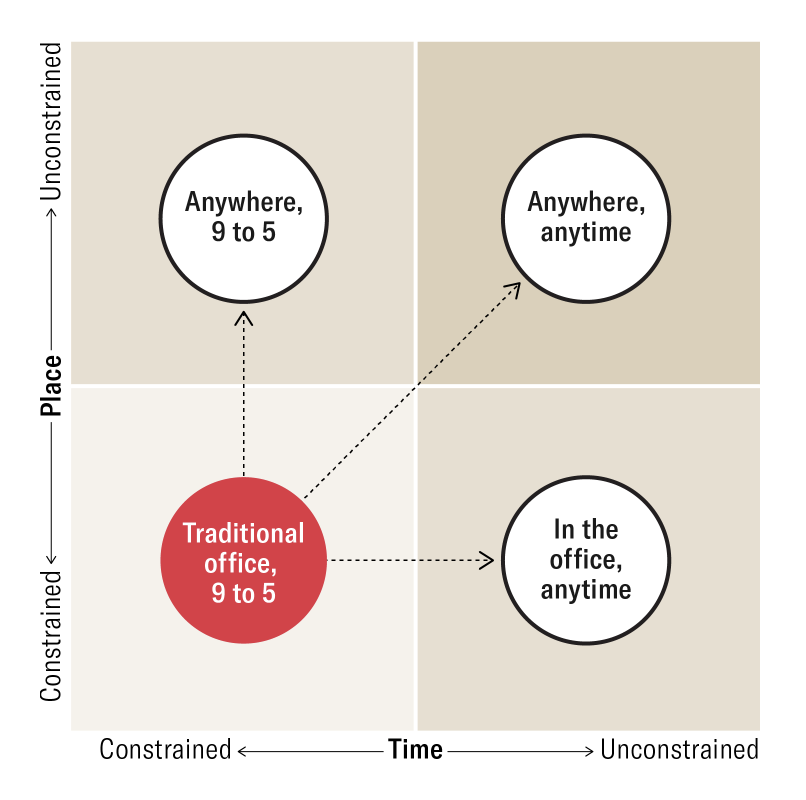
Since the pandemic, businesses have adopted remote technologies and practices remarkably quickly, realizing what is possible for work models. In our next chapter of “normal,” we are met with an opportunity to realize the advantages of more flexibility for employees and the possibility of a hybrid model.
The Harvard Business Review directs businesses to consider the evolution of:
- Jobs and Tasks
- Employee Preferences
- Projects and Workflows
- Inclusion and Fairness
All these elements have been affected by the shift from “being place-constrained (working in the office) to being place-unconstrained (working anywhere)” writes Lynda Gratton of the Harvard Business Review. No longer does work begin and end at the doors of an office building or on-site location. Instead, it has developed the capability to take the shape of wherever we are – sometimes being a laptop pulled into bed or propped up on a beach chair… I won’t tell you which I’m doing at this moment.
The nature of work has also shifted from “being time-constrained (working synchronously with others) to being time-unconstrained (working asynchronously whenever they choose)” writes Gratton. Email threads and impromptu Zoom calls have commonly replaced regular hallway run-ins and office pop-ins.
Gratton crafted a 2×2 matrix to illustrate the dimensions of this movement of Time and Place. The model displays work arrangements between the traditional office setting working 9 to 5 and the hybrid model of working from anywhere at any time.
To best understand and respond to the potential of what work can look like, we must consider not only how to optimize benefits, but also how to minimize downsides.
Setting up for success: Acclimating to new arrangements
- Jobs and Tasks
Consider what a job needs for success and center adaptations on these identifications. For example, if you find that having live conversations is necessary, then a scheduled synchronous time may be necessary to supplement other people’s shift online.
“When thinking about jobs and tasks, consider how key productivity drivers—energy, focus, coordination, and cooperation—will be affected by changes in working arrangements,” writes Gratton.
Specific needs can be met with specific directions – sounds intuitive, but it can be tempting to look for blanket answers. Try to hone in on specific issues and opportunities and identify corresponding directives.
2. Employee Preferences
Lifestyles, personalities and career status play a large role in adaptation choices. By centering choices on the diversity among these statuses, employees and employers can make choices proportional to their needs and wants.
Norwegian energy company Equinor has taken the approach of surveying employees about their preferences and assigning personas with hybrid work guidelines. Although you might not have a survey handy, you can do the work of asking about: priorities for interactions, focus abilities and desires for collaboration.
Considering how circumstance and preferences affect job capabilities can inform your decisions and get you closer to a reality that will foster an optimal work life.
3. Projects and Workflows
When deciding how and where we work, it’s valuable to assess arrangements for project and workflow commitments and conditions. As we reformat habits, there is a natural opportunity to observe what has been done and can be done.
What should not emerge from this time of work in the pandemic is a layering of flawed processes. Using what we have learned from our recent experiences and from years of work life prior, we can inform processes that best suit projects and workflows.
Consider aspects of banking that are now virtual. At one time, we thought it necessary to have face-to-face meetings and in-person signatures. By observing remote abilities and inviting redesign, a more efficient process has emerged.
4. Inclusion and Fairness
When adjusting places to each person’s need, we need to be careful of the different results. Varying degrees of flexibility and freedom can give rise to accusations of unfairness.
Emphasize decision making based on working capabilities and preferences. In circulating more information, individuals will be able to recognize what care looks like for individuals and the business as a whole. This could look like creating space for people to pitch ideas, normalizing conversations around care by having them regularly or facilitating conversations between different job holders.
People can be and will feel better represented in the process and the results when they are given opportunities to offer feedback.
Hybrid work strategies will inevitably look different from business to business, person to person. A commitment to checking-in with ourselves and each other regularly can help propel us into equitable and suitable work that makes us happy.







